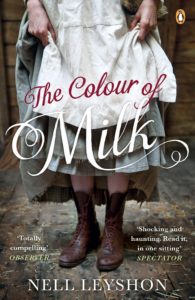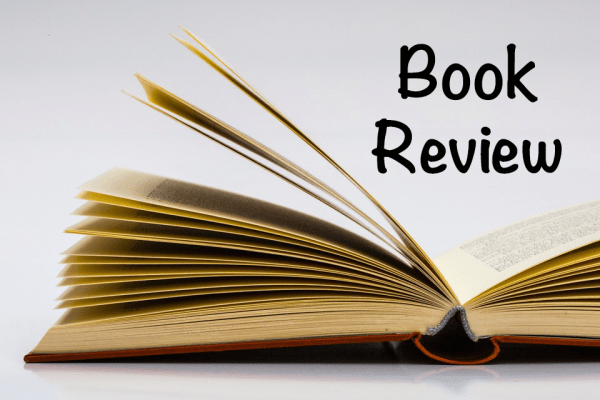“i tell the truth” The Colour of Milk by Nell Leyshon
Written by Kristy Dolson
 In my native land of Canada, after the family dinner of Thanksgiving and the festivities of Halloween have passed, November arrives somber and reserved. This year, I can think of nothing more sobering than the recent nomination and appointment of Brett Kavanaugh to the highest court of law in the USA, despite multiple accusations of sexual assault brought against him. In the Me Too era, how could this happen?
In my native land of Canada, after the family dinner of Thanksgiving and the festivities of Halloween have passed, November arrives somber and reserved. This year, I can think of nothing more sobering than the recent nomination and appointment of Brett Kavanaugh to the highest court of law in the USA, despite multiple accusations of sexual assault brought against him. In the Me Too era, how could this happen?
Well, a lot of it has to do with the narratives we tell about men and women in situations of sexual abuse, and specifically those stories that examine the consequences faced by women who have the nerve to challenge their abusers and the greater society, which dictates proper behavior. For a long, long time, these narratives were written by men, and these consequences were written as morally just, with the women cast as wicked seductresses who got what they deserved. In other words, they were cautionary tales – for women.
These days, more and more female authors are taking on these narratives in order to reframe abused women and the consequences for challenging social mores in a more sympathetic light. Alias Grace by Margaret Atwood, Burial Rites by Hannah Kent, and The Colour of Milk by Nell Leyshon are just three examples of this kind of narrative. The focus of this review will be on the latter because I read it most recently and it has the smallest page count – thus making it a perfect book to get in during the homestretch of 2018. But of course, I also highly recommend the books by Atwood and Kent, should you find your interest piqued and have some spare time in your schedule. But despite the gender of the authors, the consequences faced by the protagonists remain the same: Only the reader’s sympathy changes. Is this enough?
No. It is no longer enough to inspire sympathy in your audience. That sympathy must lead to action. We are finally, finally seeing that action with the Me Too movement and the accusers coming forward against men like Kavanaugh. In the novel, Mary likewise recounts in her own words what happens to her after the pastor’s wife takes ill and the pastor pays her father to send one of his four daughters up to be a live-in nursemaid and companion for the dying woman. Because she was born with a deformed leg, Mary is the least useful around the farm and thus the one chosen for the position. Personally, I appreciated that Mary’s state of mind is not deliberately ambiguous. Unlike the protagonists of Atwood and Kent, Mary harbors no indecision or false piety as she tells her story. She knows what happened, and more than that: She wants others to know it, too. Could this be the beginning of a new era for female protagonists? I hope so.
In this short but unique novel, we are told a familiar story in an unconventional way. Mary belongs to a poor farming family, and during the events of the book, she learns to read and write. Her informal education is reflected in the lack of proper sentence structure and capitals for proper nouns, the beginning of sentences, and even the “I” pronoun throughout the novel. At first, this strikes the reader as odd and persists as a stumbling block to the reading process, but with time the mind becomes accustomed to it, and reading becomes smoother. This symbolizes how difficult it may be for others to understand someone else’s perspective, but it is possible when we make an effort. This is a vital book to read if we want to make an effort to improve our empathy and to open a dialogue about women’s experiences in the Me Too era.
The media coverage surrounding the Kavanaugh hearings continually asked, “Are the accusers ‘credible?’ Can their memories be trusted? Are they telling the truth?” In university, I was taught to think critically about whether a protagonist was a “reliable narrator,” but now I think it hardly matters whether she is reliable. The question we should be asking is “What are the consequences if we don’t believe her?” This is a particularly disturbing question to consider because the answers will affect another generation of men and women, and will have far-reaching consequences across the globe for decades to come.
When will we start to question an individual’s humanity over her reliability? When will suffering speak louder than lack of evidence? Can we solve social problems with increased empathy? I have a lot of questions and very few answers. And I am honestly terrified for the future of Western culture – driven for so long by the USA – which continues to place men and women in such blatant opposition over issues of sexual abuse. But I have always been an optimist at heart, and I have to keep the faith that the narrative can and will be changed. It begins now, with listening to victims and believing their stories. As Mary herself writes: “if i was not telling you the truth why would i have told you any of it?”
Why indeed?
The Author
Kristy Dolson lived in South Korea for five years before taking a year off to travel, read, and spend time with her family in Canada and Australia. She holds a Bachelor of Education and has just moved to Yeosu, where she splits her time between teaching at the new Jeollanamdo International Education Institute and reading as much as she can.





